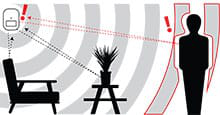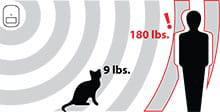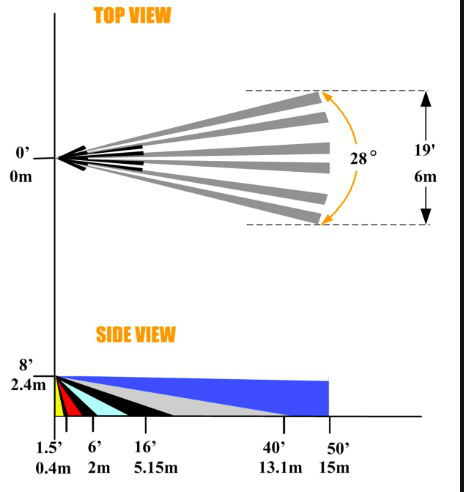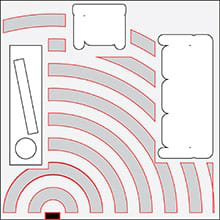1. Types of Motion Sensors
Passive Infrared (PIR) Motion Sensor
Detects body heat (infrared energy). Passive infrared sensors are the most widely used motion in home security systems. When your system is armed, your motion sensors are activated. Once the sensor warms up, it can detect heat and movement in the surrounding areas, creating a protective “grid.” If a moving object blocks too many grid zones and the infrared energy levels change rapidly, the sensors are tripped.
MircoWave (MW) Motions Sensor
Sends out microwave pulses and measures the reflection off a moving object. They cover a larger area than infrared sensors, but they are vulnerable to electrical interference and are more expensive.
Dual Technology Motion Sensors
Motion sensors can have combined features in an attempt to reduce false alarms. For example, a passive infrared (PIR) sensor could be combined with a microwave sensor. Since each operates in different areas of the spectrum, and one is passive and one is active, Dual Technology motion sensors are not as likely as other types to cause false alarms, because in order for the alarm to be triggered, both sensors have to be tripped. However, this does not mean that they never cause false alarms.

Pet Immune Motion Sensors
A passive infrared sensor can be set up to ignore animals up to a certain weight. A dual technology motion sensor is more resistant to false alarms caused by animals because it requires two sensors to be triggered in a manner determined by the manufacturer. They can be set up to ignore a large animal or multiple small animals without setting off a false alarm. Some pet immune motion sensors have a sensitivity level that can be adjusted for families with very active animals.

Wired Motion Sensor
Wired motion detectors are hardwired security devices that work to detect the presence of motion. Upon sensing motion, the device will conduct a predetermined response from wires to the system. Typically the wired motion detector connected with wired alarm system panel,but sometimes they can even be used for home automation.

Wireless Motion Detector
Wireless motion detector is designed to activate whenever there is a significant amount of motion that suggests the presence of an intruder. Once the motion detector has activated, it will using RF technology to send a signal to the security system in order to take a specific action. The action that is taken will depend upon how the sensor was programmed with the system. Some users program their motion detectors to send an immediate signal to the central monitoring station as soon as they are activated. The programming setup that you should use will depend on your unique needs as an end user.
Wide Angle PIR Motion Sensor
Wide Angle PIR features a larger detection angle of from 60˚ to 180˚. This makes it ideal in applications where users need to track movements across a large, open area.

Curtain PIR Motion Sensor
Curtain PIR-based motion detector using special fresnel lens to create a very slim detection space (like 15 degree). Curtain PIR-based motion detectors are installed in front of window, only protection of window, people still can move inside of house and will not cause the alarm.

Ceiling Mounted Motions Sensors
Ceiling PIR Motion sensor mount on the ceiling of floor with the 360 degree detection angle.

2. The Role of Motion Sensors in Your Home Security
The main purpose of motion detection is to sense an intruder and send an alert to your control panel, which alerts your monitoring center. Sensors work when you are not home, or when you tell the system you are not there. Some security systems can be programmed to record events via a security camera when motion is detected.
Motion sensors stand guard, ready to react to various situations, such as movement in your living room, windows or doors being opened or closed, or a broken window. Motion sensors can:
- Alert you in the event that your teen breaks curfew
- Trigger a doorbell when someone approaches the front door
- Alert you when kids enter restricted areas in the home, like the basement, workout room, or medicine cabinet
- Save energy by using motion sensor lighting in unoccupied spaces
- Notify you if pets enter areas where they’re not supposed to be

3. Motion Sensor Placement Tips:
Keep in mind that motion sensors aren’t error-proof, and there are instances in which there could be false alarms. False alarms are usually caused by electrical failures, user error, poor application engineering, power surges, lightning, and faulty equipment. They can also be triggered by animals, insects, and foliage.
The best thing you can do to increase the effectiveness of your sensors and prevent false alarms is to read the instructions that come with your sensors. Also, consider the following motion sensor placement tips:
1) Keep PIR sensors 10—15 feet away from heating vents, where the sunlight shines in, and radiators. If a motion sensor detects a swift change in heat, even that of a cloud passing quickly over direct sunlight shining into your living room, it could be tripped.
2) Place motion sensors at “choke-points”—areas where people have to walk through, like the stairwell or main hallway. That way, an intruder will trip the sensor regardless of where they are headed. Intruders usually go right for the master bedroom, so put a sensor near that room or other rooms where you have valuables, like the study.
3) Walk through your house and assess where intruders are most likely to enter, and what path they would take. Keep in mind that most motion sensors can detect between 50 and 80 feet. Most burglars enter the home through a front or back door, patio door, or garage door, so it’s advisable to place the sensors near those areas.
4) Motion sensors work best when the intruder walks parallel to the sensor, not toward it. For example, in a hallway you tend to walk parallel to the walls, not directly toward them. Find walls that an intruder would walk alongside, like a hallway or narrow pathway that leads to a room.
4. Other Uses for Motion Sensors
Motion sensors aren’t just used for home security. In industrial fields, they are used on assembly lines to keep track of the number of products and to shut down dangerous equipment if a person gets too close.
Here are a few other ways motion sensors are used:
- To open and close automatic Doors
- To turn on and off automatic water faucets and toilets
- To turn on lights when a person enters a room
- To control ATM displays
- At automatic ticket gates
- For some parking meters
Motion sensors aren’t just an additional feature of a security system—they are essential. Without sensors, there wouldn’t be a way to detect intruders.



